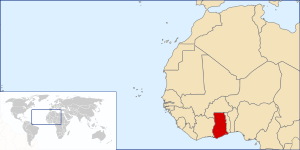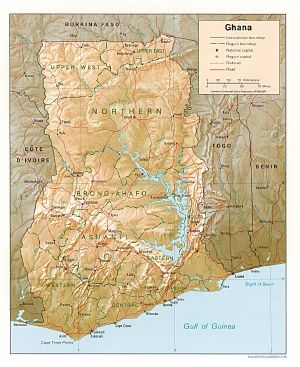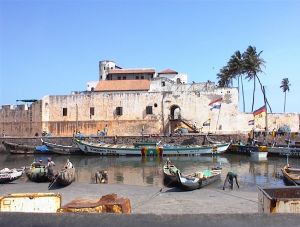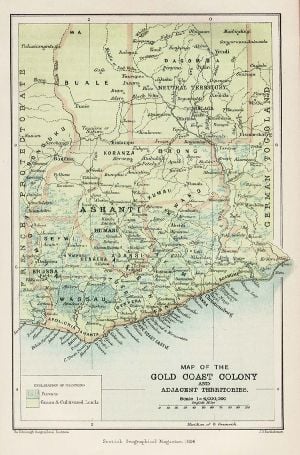Fante Confederacy
 From Nwe
From Nwe 
The Fante Confederacy can refer either to the loose alliance of the Fante (or Fanti) states in existence at least since the eighteenth century, or it can refer to the briefly lived Confederation formed in 1868 and dissolved in 1874, when the British Gold Coast Colony was proclaimed. The Confederation is seen as one of the first self rule movements in Africa, with a written constitution. However, it enjoyed support from the British Empire from towards the beginning of their colonial exploits in Africa, and played a role in their opposition to the larger and more powerful Asante Union, who controlled the interior, including the gold and diamond deposits.
Initially, the British entered an alliance with the coastal Fante to enable access to off-shore anchorage and to on shore transportation. After initially supporting the Confederacy and using the Fante to aid their anti-Asante policy, it was the British who eventually wound-up the Confederacy, perhaps seeing its level of sophistication as a threat to their thesis that Africans required civilizing, organizing and supervising. It is doubtful that the British properly honored their treaties with the Fante, and it is certain that they manipulated them for their own purposes. Yet, while it lasted, the confederacy was a genuine African enterprise, one that cannot be dismissed merely as an artificial, puppet-state created by Europeans. Given that the European powers had a firm footing in the region when the Fante formed their polity it is not surprising that it did not survive British expansion.
Initially, the British were represented by trading companies under royal charter. Later, towards the end of the nineteenth century, as the idea of a civilizing mission gripped the British imagination, these companies (The British Royal African Company was founded in 1672 and was replaced in 1751, by the Company of Merchants Trading to Africa) were transformed into colonial administrations, following the pattern of how the British East India Company evolved in the Indian context. Originally, the British had only taken an interest in Africa, except for the slave-trade, because their ships sometimes had to stop en route to India, where real profit could be made. Later, they realized that involvement in Africa could also yield economic benefits and they applied to what they called the "dark continent" many of the lessons they had learned from their “divide and rule” policy in India, where, setting one state off against another, they emerged as master of both. Examining Britain's dealings with the Fante vis-à-vis the Asante, we see that in the end both ended up as subjects of British rule. The Scramble for Africa was picking up momentum, and with the French on one side and Germans on the other, the Confederacy would have fallen at some stage to one or other of the colonial powers, if it had not fell to the British.
Fante expansion

The Fante had long been in the region both in-land and on the coast of what is today Ghana. In the sixteenth century, they began to expand along the coastal areas in order to defend from foreign invaders. The establishment of the confederacy was a proclamation of the several small independent kingdoms that made-up the Fante tribes.
The standard explanation has long been that the Fante states were forced to form a confederation by the rapid growth of the Ashanti Confederacy in the early eighteenth century that began to threaten the security of the surrounding region. Sanders argues that the same forces that were driving the expansion and centralization of the Ashanti, the lucrative trade with the Europeans and the introduction of firearms and other weapons, also fueled the increasing unity of the Fante. The Fante united and produced a confederacy to be recognized not only by the people of the Gold Coast, but also by the European powers. The confederacy was headed by the Chief of Mankessim, who was given the title of Breyni. It was the obligation of highest Chief to respect the wishes of a council of the leaders of the other major towns. Despite a similar political structure the Fante never managed to become as united as the Ashanti, though their differences were overcome when their kingdoms were under dire threat. During the early eighteenth century the Fante expanded at the expense of smaller neighboring states eventually annexing the lands of the Asebu, Cabesterra, and Agona. The Fante were allies of the British who supported their efforts against the rival Dutch, who were aligned with the Ashanti. The Fante Confederacy was smaller than the Ashanti, but through their control of the coastal trade and close links with the British the Fante became the administrators of the entire Gold Coast. The Fante leaders were the best educated and wealthiest of the people's in the region.
Conflict with the Ashanti
For the first half of the eighteenth century, the Ashanti were preoccupied with expanding their confederacy to the north rather than against the stronger coastal groups. The next few decades saw internal disputes within Ashanti. The Fante subsequently intervened, lending material support to rebel groups in Ashanti and offering safe harbor to refugees and dissidents fleeing the Ashanti Confederacy. The Fante introduced laws forbidding the selling of firearms to the Ashanti and curtailing the amount of trade that could pass between over Fante lands, cutting off supplies to the confederacy. They were also the main intermediaries in the gold-trade between the Ashanti and the Europeans but would debase this before selling on to the traders.
By the early eighteenth century the Ashanti had consolidated the large parts of the middle region under their rule and began to plan for a full-scale invasion of the Fante Confederacy. In 1806, the Ashanti-Fante War began. The Ashanti army, the best-armed and trained in sub-Saharan Africa, easily routed the Fante. The British felt unable to intervene and acknowledge Ashanti control of the region. However, the first armed skirmish between the British and the Ashanti occurred the same year, and on and off the two side engaged in a war that did not end until 1896.
The British continued to work with the Fante to curtail the Ashanti. With advice from the British in 1811, the Fante again went to war. While defeated in open battle the Fante were able to win the war by forcing the Ashanti to withdraw by employing guerrilla tactics. For the next several decades, the Fante worked to play the Ashante off against the British while maintaining their independence, over time, however, British influence came to dominate the Fante lands. In 1844, the Fante leaders agreed to a bond with the British that made the area a protectorate of the British, but guaranteed internal control would remain with the local rulers.
Tensions with the Europeans

However, the British soon began to exceed the agreement, and intervened in life along the coast. The Fante leaders were displeased, and also felt the British were not doing enough to protect them from the Ashanti. The most controversial action was an 1868 agreement between the British and Dutch to trade forts along the coast. Previously, the entire coast had been a mix of British and Dutch forts. The British and Dutch governments agreed to exchange forts whereby the British would control all the forts east of the River Kakum, and the Dutch would get all the forts to the west, including most of those in the Fante areas. It has also been argued that the local elites were angered by the abolition of the profitable slave trade by the European powers.
These factors greatly annoyed the people throughout the region. Legally, the local rulers saw the Europeans as tenants, and they demanded the right to approve the fort exchanges. The local rulers were not even consulted before the agreement was announced. The Fante also worried about the close relations between the Ashanti and the Dutch.
Creation of the confederacy
This led to an 1868 meeting of the leading Fante and also representatives of the Denkyira, Wassa, Twifu, and Assin who met in Mankessim and formed a Confederation. The group proclaimed their loyalty to the British protectorate, but also demanded the right to self-government. They also promised to prevent the Dutch from assuming control of the forts in the area.
The new state had a King-President at its head and below him, a council of kings and elders and a national assembly representing a larger portion of the population. King Ghartey was elected as the first King-President while King Otoo of Abura was placed in charge of the armed forces. The new government created a standing army of some 15,000 men, introduced a poll tax covering the region, and most importantly a judicial system that asserted the right of the Confederation, not the British, to mete out justice. This Confederation was paralleled in the east by the Ga lead Accra Native Confederation
Otoo marched the new army to Komenda to join that city in its effort at preventing the Dutch from taking control of the fort vacated by the British. This effort was successful and the Dutch were rebuffed. Otoo next turned to trying to take Elmina, the centre of Dutch power on the coast. The effort to storm the city failed and the Fante forces became bogged down in a long war. In 1871, the constitution was rewritten and a new Executive Council was created. Otoo and Edu of Mankessim were elected co-King-Presidents, but shortly Otoo's role was switched to the General Field Marshal and Edu became the sole King-President.
Fall of the Confederacy

The long fighting around Elmina soon began to drain the resources of the state. It proved unable to collect much of the poll tax, and the British refused to allow the Confederacy to tax lucrative trade in the region. For a time the Ghartey brothers funded the state out-of-pocket, but soon the Confederacy was all but broke. Moreover the fighting with the Dutch and its allies had left the northern part of the Confederacy, on the border with the Ashanti, undefended and these regions felt the Confederation was failing to provide the needed protection.
British reaction to the Confederacy was mixed. Originally they had little interest in directly administering the region themselves and some felt a self-governing European style state was a positive development. More British representatives in the region and in London saw the Confederacy as a dangerous precedent that was anti-British and doomed to failure. The Dutch, while winning militarily against the Fante, could little afford to fight a war in West Africa and decided to abandon the entire Gold Coast. The British, now in control of the entire region, approached the leaders of the Confederation and offered them money and to defend them against the Ashanti if the Fante acquiesced to being annexed to the Gold Coast this was done and the Confederation ceased to exist in 1873. The colony was proclaimed on July 24, 1874.
References
ISBN links support NWE through referral fees
- Lundgren, Nancy. 2002. Watch and Pray: A Portrait of Fante Village Life in Transition. Fort Worth, TX: Harcourt College. ISBN 9780155059337.
- McCarthy, Mary. 1983. Social Change and the Growth of British Power in the Gold Coast: The Fante states, 1807-1874. Lanham, MD: University Press of America. ISBN 9780819131485.
- Okeke, Chika. 1998. Fante. The Heritage Library of African peoples. New York: Rosen Pub. Group. ISBN 9780823919819.
- Sanders, James. 1979. "The Expansion of the Fante and the Emergence of Asante in the Eighteenth Century." Journal of African History. 20:3:349-364.
Credits
New World Encyclopedia writers and editors rewrote and completed the Wikipedia article in accordance with New World Encyclopedia standards. This article abides by terms of the Creative Commons CC-by-sa 3.0 License (CC-by-sa), which may be used and disseminated with proper attribution. Credit is due under the terms of this license that can reference both the New World Encyclopedia contributors and the selfless volunteer contributors of the Wikimedia Foundation. To cite this article click here for a list of acceptable citing formats.The history of earlier contributions by wikipedians is accessible to researchers here:
- Fante Confederacy history
The history of this article since it was imported to New World Encyclopedia:
- History of "Fante Confederacy"
Note: Some restrictions may apply to use of individual images which are separately licensed.
↧ Download as ZWI file | Last modified: 02/04/2023 01:06:58 | 22 views
☰ Source: https://www.newworldencyclopedia.org/entry/Fante_Confederacy | License: CC BY-SA 3.0
 ZWI signed:
ZWI signed: KSF
KSF